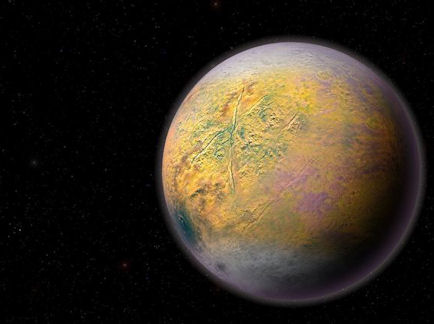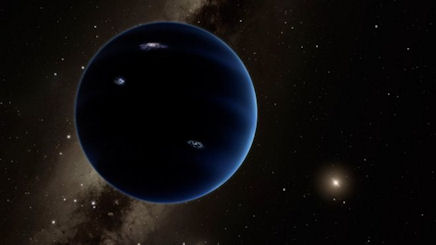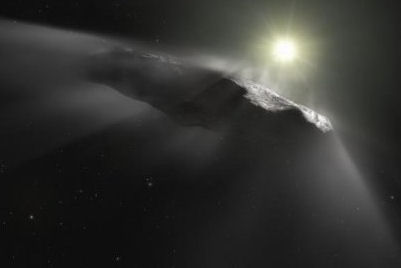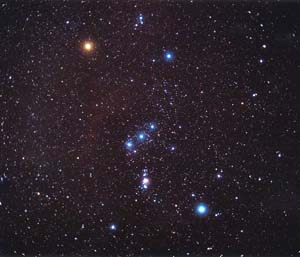
Andy Lloyd's Dark Star Blog

Blog 79 (January-March 2020)
139 New TNOs Boost Planet Nine Search
The Planet X
story has always had peaks and troughs, and at the
moment it is going through one of its quieter times - at
least in terms of the planet's internet presence.
However, that's not to say that work to find the
so-called Planet Nine body has stopped. Far from
it! Such work is by its very nature slow and
long-term. An example of this work is the sky
search being conducted by Chad Trujillo and Scott
Sheppard, looking for objects beyond Neptune.
These two professional astronomers, who between them
have racked up a handsome bag of Kuiper Belt (...and
beyond!) goodies consider the prospects of finding
Planet Nine to be above 80% (1).
How Planet X might
have got here remains a contentious issue. Various
scenarios are under consideration. The two
astronomers wonder whether it might have been captured
early in the history of the solar system. With the
discovery of two interstellar visitors in the last
couple of years, it's clear that free-floating materials
routinely travel the galactic highways, encountering
stars. No reason to think such objects couldn't
include whole planets. The issue, then, is how the
Sun could capture a planet moving at such incredible
speeds. Interstellar objects would be travelling
on hyperbolic trajectories with respect to the Sun,
meaning their speeds should remain fast enough to
achieve escape velocity from the solar system after
their encounter with our star. The astronomers
offer this possibility:
"...for the Sun to
capture such a planet, “you’d have to slow it down
somehow,” Sheppard says. “So that’s the questionable
factor.” Although capturing an ejected planet isn’t the
easiest thing to do, Sheppard points out it could
happen. For example, he says, there was probably a lot
more gas and dust around in the early solar system,
meaning an approaching planet “could have been
frictionally slowed down and captured.”" (1)
Other workers are also scanning the skies for Trans-Neptunian Objects,
too. The Dark Energy Survey has identified over 300 such objects,
with a new paper this month publishing details of 139 new discoveries
for the first time (2). The new objects lie between 30 and
90 astronomical units (AU) from the Sun. This is equivalent to a
remarkable 5% boost in TNO numbers, which currently stands at about
3000. But even though the Dark Energy Survey completed its astronomical
work in 2019, the tally may not yet be complete: further computational
work on their accumulated dataset has the potential to throw up another
500 new objects (3).
Such objects may well pave the way towards Planet X's distant location.
The more distant of these objects will no doubt be considered in terms
of Planet Nine clustering, adding further to the lively debate about the
theoretical 'proof' for the existence of this mysterious world (4).
More on this in my book 'Darker Stars' (5).
The Trans-Neptunian ranks may yet swell further with the capability of
the new Vera C. Rubin Observatory, in Chile, to detect even more distant
objects than the Dark Energy Survey (6). This is scheduled to
begin work in the early 2020s.
Written by Andy Lloyd, 26th
March
2020
References:
1) Jake Parks “In pursuit of Planet Nine” 3 January 2020
astronomy.com/magazine article
2) Pedro Bernardinelli et al
“Trans-Neptunian Objects Found in the First Four Years
of the Dark Energy Survey” 10 March 2020 The
Astrophysical Journal Supplement Series, 247(1)
3) Mike Wall “'Minor planet' bonanza: 139
new objects discovered beyond Neptune” 13 March 2020
4) Robert Perkins “More Support for
Planet Nine” 27 February 2019
5) Andy Lloyd
"Darker Stars" Timeless
Voyager Press 2019
6) Jamie Carter “Is ‘Planet 9’ Next?
Staggering Haul Of 139 Minor Planets Found In Outer
Solar System” 16 March 2020

Twisted Dust Disks
Astronomers using the ALMA telescopes have noticed that the protoplanetary dust disks around wide binary stars are distorted (1). The worlds that might form out of these disks are known as 'Tatooine planets'. The Kepler space telescope has so far discovered about a dozen of these worlds - a prime example being the planets discovered orbiting two-star system Kepler-47 (2). If the two stars are close together, then the circumbinary disk is aligned with the plane of the stars. However, if the stars are far apart, then the protoplanetary disk is misaligned with the inner binary stars. In other words, the disks are tilted or warped away from the plane of the stars. Although no misaligned planets have yet been discovered, its seems likely that they exist, awaiting discovery.
Although the tilt of the stars in these systems is not able to be determined, there is a prevalent assumption in single star systems that the protoplanetary disk will be aligned with the equator of the parent star. In the Sun's case, surprisingly, this is not the case. The 'obliquity' of the Sun - the angle between the axis of rotation and the direction perpendicular to the orbital plane - is tilted by about 6 degrees. The astrophysicists who have proposed the existence of Planet Nine consider this to be evidence of an outside influence (3). This misalignment between the Sun and the orbits of the planets is understandable if a distant massive planet was located at a significant angle from that plane, tugging the other planets out of the 'natural' plane in the equatorial plane of the Sun. If the planet were massive enough, then this effect may be reminiscent of what is being discovered about the misaligned circumbinary disks discussed above.
Image credit: ALMA (ESO/NAOJ/NRAO), I. Czekala and G. Kennedy; NRAO/AUI/NSF, S. Dagnello
Recent work by Planet Nine astrophysics
dynamicist Konstantin Batygin et al. has looked at
whether the stellar conditions surrounding the early Sun
might have caused the observed obliquity of the Sun.
Their calculations indicate that the influence of the
stellar nursery is not sufficient to cause this effect:
"...cluster effects can alter the mean
plane of the solar system by < 1 deg, and are thus insufficient to
explain the ψ ≈ 6 deg obliquity of the sun."
In the same paper, the prospect of a stellar flyby, and its potential influence on drawing out the Kuiper Belt population is also considered. Their computations indicate that such an effect could take place, but that the distribution of objects would not look like that observed. By default, this more or less leaves the Planet X option.

Image credit: Caltech
These are all outside influences, of
course. A substantial Planet X object would lie outside
the protoplanetary disk of dust and gas (or, at least, it does now).
Similarly, the influence of the early
stellar nursery, or early stellar flybys, would also be
external, and these contrast with the effect wide orbit
binary star effect. Still, it would be interesting
to consider the influence on a sizeable binary object,
like a brown dwarf, on the early solar system. Batygin
muses along similar lines on Twitter:
"I'm partial to disk-torquing by a
primordial binary stellar companion as a plausible explanation for the
solar obliquity."
How sizeable such a 'lost' binary stellar companion might be remains open to conjecture...
Written by Andy Lloyd, 24th March 2020
References:
1) National Radio Astronomy Observatory “The Strange Orbits of ‘Tatooine’ Planetary Disks” 19 March 2020,
2) Mike Wall “Discovery! 3rd Planet Found in Two-Star 'Tatooine' Star System” 16 April 2019
3) Shannon Stirone “Planet Nine may be responsible for tilting the Sun” 19 October 2016
4) Konstantin Batygin, Fred Adams, Yuri Batygin, and Erik Petigura “Dynamics of Planetary Systems Within Star Clusters: Aspects of the Solar System’s Early Evolution” 14 February 2020, The Astronomical Journal, 159(3)
5) Konstantin Batygin @kbatygin 14 February 2020
Eccentric Gas Giant in Habitable Star System
One of the arguments against the potential for an eccentric Planet X object is the level of disruption it would cause to the solar system. This would be a particular challenge if the Planet X object was (a) capable of moving through the planetary zone of the solar system during its perihelion passage and (b) very massive. It is generally thought that such an object would 'perturb' the orbits of other planets, leading to chaos. Because the solar system appears relatively orderly, its neat arrangement is given as a reason for the non-existence of Planet X. However, as our knowledge of other planetary systems improves, assumptions about their own dynamics have been brought into question. Eccentric massive planets have been discovered, and the effects their remarkable orbits would have upon their neighbours have been considered, and computed.
Image credit: W. M. Keck Observatory/Adam Makarenko/UC Riverside.
For example, HR 5183 b is a gas giant exoplanet that orbits a Sun-like star some 103 light years away. The exoplanet's mass is 3.23 Jupiters, and, located 18 astronomical units from its star, it takes 74 years to complete one orbit (1). The image to the right shows just how eccentric HR5183 b's orbit is (not dissimilar to some depictions of a Planet X object in our own solar system, albeit entirely bound within the scope of a standard planetary system). Remarkably, recent research has shown that Earth-like planets could exist within such a system (2).
Image Credit: NASA
Not only that, but such worlds might still be capable of supporting life:
"The presence of such giant planet orbits are intrinsically interesting from the perspective of the dynamical history of planetary systems, and also for examining the implications of ongoing dynamical stability and habitability of these systems. In this work, we examine the latter, providing results of dynamical simulations that explore the stable regions that the eccentric orbit of the HR 5183 giant planet allows to exist within the habitable zone (HZ) of the host star. Our results show that, despite the incredible perturbing influence of the giant planet, there remain a narrow range of locations within the HZ where terrestrial planets may reside in long-term stable orbits. " (3)
This provides clear evidence that the routine incursion of a massive planet within the orbit of Jupiter need not lead to inner solar system ruin. Bear in mind that HR 5183 b is over 3 times the mass of Jupiter! Consider extending such a planet's orbit out further, so that it takes on more of a Planet X character: There is evidently little impediment to the life-bearing chances of the inner solar system in such a scenario.
Written by Andy Lloyd,
2nd January 2020References:
1) NASA Astrobiology "A Wrecking Ball in the HR 5183 System – Massive Gas Giant Exoplanet With Eccentric Orbit" 30 December 2019 with thanks to Mark
2) Deborah Byrd "Giant planet HR 5183b would look 15 times brighter than Venus" 5 November 2019
3) Stephen Kane and Sarah Blunt “In the Presence of a Wrecking Ball: Orbital Stability in the HR 5183 System” 31 October 2019, The Astronomical Journal, 158(5)
A Interstellar Comet's Fate
It looks like the interstellar comet 2I/Borisov is breaking up (1). It
is currently moving away from the Sun, having reached perihelion in
December 2019. Now, it is brightening intermittently, indicating
that some of its contents are being shed dramatically (2). This offers
astronomers an opportunity to discover what this interstellar intruder
is made of.
Image credit: NASA, ESA, and D. Jewitt (UCLA)
It is already known that water is present in 2I/Borisov
(3), and in many regards this external comet appears similar to long
period comets visiting from the solar system's own Oort cloud:
"The nucleus is probably ~1 km
in radius, again a common value among Solar System
comets, and has a negligible chance of experiencing
rotational disruption. Based on these early
characteristics, and putting its hyperbolic orbit aside,
2I/Borisov appears indistinguishable from the native
Solar System comets." (4)
These unremarkable properties (so far as we know) makes this
interstellar comet a very different beast from the first interstellar
comet to have been detected - the rather bizarre cigar-shaped 1I/'Oumuamua.
This interstellar visitor defied categorisation, falling into neither
classical asteroid nor comet basket. It seemed to emerged from
deeper within a star system than a more standard comet like 2I/Borisov,
leading to arguments that 'Oumuamua may represent a surviving fragment
of a disrupted planetesimal, mashed up by interactions with neighbouring
gas giants (5).
Image credit: M. Kornmesser/ESO
One of the (many) oddities about 'Oumuamua was its low mass-to-area
ratio, which may have made it susceptible to radiation pressure from the
Sun. This may have explained its observed anomalous
acceleration post-perihelion, despite a seeming lack of cometary
out-gassing (6). The low mass-to-area ratio could have caused a
degree of drag capture by interstellar gas clouds, which could have
implications for the galactic population of similar objects (7). In
other words, there could be a lot of 'Oumuamuas out there. Also,
their 'adjusted' trajectory (as a result of being dragged back by
encounters with interstellar gas clouds) should make them easier to spot
early on, potentially enabling future missions to intercept these
interstellar visitors.
Written by Andy Lloyd, 24th
March
2020
References:
1) Michelle Starr “It Looks Like That Interstellar Comet Came All The Way to The Solar System to Die” 23 March 2020 with thanks to Lee
2) Michal Drahus and Piotr Guzik et al “Multiple Outbursts of Interstellar Comet 2I/Borisov” 12 March 2020
astronomerstelegram.org article
3) Adam McKay et al. “Detection of a Water Tracer in Interstellar Comet 2I/Borisov” The Astrophysical Journal Letters, 889(1) 20 January 2020
4) Piotr Guzik et al “Initial characterization of interstellar comet 2I/Borisov” Nature Astronomy Letters January 2020 4: 53-57
5) Sean Raymond et al. “Implications of the interstellar object 1I/'Oumuamua for planetary dynamics and planetesimal formation” Monthly Notices of the Royal Astronomical Society, May 2018, 476(3): 3031-3038
6) Shmuel Bialy and Abraham Loeb "Could solar radiation pressure explain 'Oumuamua's peculiar acceleration?” 20 November 2018 The Astrophysical Journal Letters, 868(1)
7) T. Eubanks “High-drag Interstellar Objects and Galactic Dynamical Streams” 27 Mar 2019 The Astrophysical Journal Letters, 874(2)
Is Betelgeuse about to go Supernova??
It's a bit like predicting when volcanoes are about to blow. At around 10 million years, red supergiants have short lives by 'normal' star standards, but the margin of error for predicting when they will become supernovae is plus/minus a million years or so. The bright red star Betelgeuse (some 8.5 million years old), located in the constellation Orion, has reached the end of its relatively short life, and is currently behaving a little oddly.

It's a variable star - 'normally', its diameter changes from anywhere between 550 to 920 times that of the Sun (1). Betelgeuse's recent dimming has taken its magnitude down to a level that has not been observed for over 100 years (2). Astronomers noted that the star's shape had become irregular - taking on an oval appearance. Yet its temperature has not changed particularly. This darkening may have been due to release of an immense amount of dust which served to obscure the star's southern hemisphere from our vantage point (3).
Image credit: ESO/M. Montargegraves et al.
Efforts aimed at working out any periodicity to Betelgeuse's variability have proven challenging:
"Decades of photometric data show that Betelgeuse brightens and dims in cycles, with one notable cycle vacillating on a roughly six-year timescale, and another rising and falling every 425 days or so... The reasons for these quasiperiodic changes in variations are somewhat unclear. Guinan and others say that supergiant stars like Betelgeuse have mottled surfaces containing massive convective cells that shrink and swell, which cause such stars to darken and brighten, but that’s not the whole story. “Images of Betelgeuse show bright and dark features on its surface, and at times it is not symmetrical,” [Villanova University astronomer Edward] Guinan says. “The star is bloated and unstable, with pulsations, as well.” (4)
There is speculation that this change in behaviour may mark the point where it enters the next stage in its life cycle. And if Betelgeuse detonates, it will be a spectacular event in the night sky. The supernova occurs as a result of the dying star's core collapse, remnant formation and ejection of its outer layers. In the hours before this happens, Betelgeuse would likely release an abundance of neutrinos (5), which might give astronomers a heads-up that something is definitely afoot.
Being a supergiant, Betelgeuse's luminosity is already pretty spectacular - at 100,000 times more than the Sun. Its destruction would increase Betelgeuse's luminosity to the equivalent of half the brightness of a full Moon, probably making it a daytime celestial object for a period of months. However, at a distance of about 600 light years, there's sufficient space between us to make our vantage point safe - even if the red star was to violently explode.
All this lies somewhere in the future, of that wee can be certain. Pinning down the timing is tricky though. Since January 2020, Betelgeuse has brightened once again, defying expectations that it was about to explode into a glorious supernova (6). Relief, I'm sure, for any alien civilisations in its vicinity, but perhaps not the news we on Earth hoped for. Still, we have enough to worry about at the moment, don't we?
Written by Andy Lloyd, 24th March 2020
References:
1) Elizabeth Howell "Betelgeuse: The Eventual Supernova" 9 August 2017
space.com/22009-betelgeuse.html
2)
Erika Carlson "Betelguese's bizarre dimming has astronomers scratching their heads" 27 December 20193) Emily Levesque and Philip Massey “Betelgeuse Just Isn't That Cool: Effective Temperature Alone Cannot Explain the Recent Dimming of Betelgeuse” 24 February 2020, accepted for publication in ApJ Letters
4) Nadia Drake "A giant star is acting strange, and astronomers are buzzing" 27 December 2019
5) Elizabeth Gibney "How to blow up a star" 18 April 2018
6) Nadia Drake “Oddly dimming star isn’t about to explode after all” 28 February 2020

You can keep informed of updates by following me on Twitter:
![]()
Or like my Facebook Page: https://www.facebook.com/darkstarandylloyd